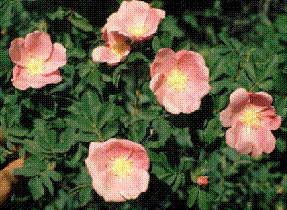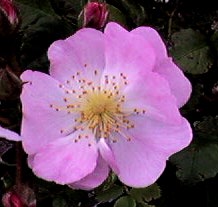Prairie Wild Rose (Rosa arkansana)

Alas a more distinctive species could well have been selected for the North Dakota state flower, because prairie wild rose can be found from Alberta to Texas northeastward to New York at elevations up to 9000 feet.
Prairie wild rose often appears herbaceous, but actually is a small shrub. Plants spring from stout horizontal roots and usually are less than a foot tall in our area, dying back to the ground each winter. However, some plants persist as obvious shrubs up to three feet tall. Stems are beset with reddish prickles. The alternate leaves are odd-pinnate with 7-11 leaflets toothed on the upper half. The five-petalled flowers are about two inches wide, and vary from pink to white or rarely deep rose. Three or more flowers are borne on new-growth branches that are unarmed with prickles. Fruits consist of a swollen body (hip) that contains numerous bony achenes in a fleshy matrix. Seeds inside the achenes have thin coats. Many varieties and hybrids of prairie wild rose have been described.
Look for prairie wild rose in prairies, sandy tame pastures, roadsides, and at the edges of woods. Plants seem to slightly more abundant in heavily and moderately grazed pastures in cool moist soils of eastern and central North Dakota, but decrease under heavy grazing in the warm dry soils to the west. Roses are used as foods (preserves, candies, sauces), drinks (teas, wines), flavorings, and perfumes, and the essential oils have been used as medicines.
The rose family (Rosaceae) contains about 3000 species cosmopolitan in distribution but most abundant in the north temperate zone. Many fruits (apple, plum, pear, cherry, apricot, raspberry) and ornamentals (quince, spirea, cotoneaster) are members of this family. Rosa is the ancient Latin name of the rose. The genus Rosa contains over 100 species, all of the northern hemisphere. The specific epithet arkansana was named for the Arkansas River of Colorado. Prairie wild rose was first described for science in 1874 by Thomas Conrad Porter (1822-1901), author of the Flora of Pennsylvania (1903).

Wild Rose
Family: Rose
Size: 1 inch
Date: Early May
![]()
![]()
Back to Plants
 Wildflower
Seed For Sale
Wildflower
Seed For Sale